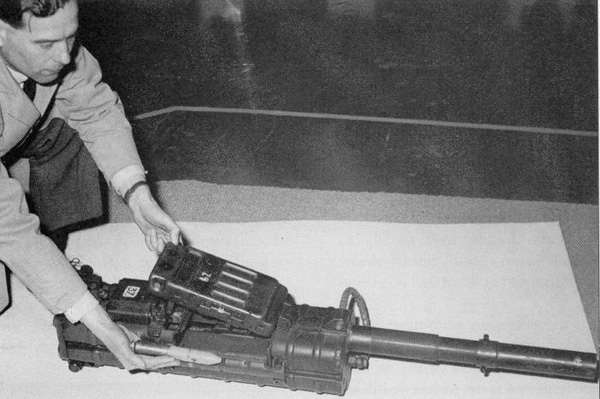
|
 |
Mk 108 Cannon |
 |
 |
 |
 |
 |
|---|---|---|---|---|---|---|---|
 |
 |
 |
 |
 |
|||
 In 1942, the German Ministry of Aviation (Reichsluftfahrtministerium or RLM) issued a requirement for a heavy aircraft weapon for use against Allied bombers during World War II. In response to the RLM, Rheinmetall-Borsig submitted its design for the Mk 108. The MK 108 was a 30 mm caliber auto-cannon developed as a private venture in 1940. The Mk 108 was accepted by the RLM and quickly ordered into production.
In 1942, the German Ministry of Aviation (Reichsluftfahrtministerium or RLM) issued a requirement for a heavy aircraft weapon for use against Allied bombers during World War II. In response to the RLM, Rheinmetall-Borsig submitted its design for the Mk 108. The MK 108 was a 30 mm caliber auto-cannon developed as a private venture in 1940. The Mk 108 was accepted by the RLM and quickly ordered into production.
The gun was relatively light and easy to manufacture. The construction was simple with approximately 80% of the gun used stamped parts and the total number of parts kept to a bare minimum. It proved to be an effective and very reliable weapon and was optimized for a high rate of fire. Weapon maintenance was minimal and its compact size made it suitable for aircraft use. It had a relatively low muzzle velocity and was designed to attack bombers and not fighter aircraft. The bullet drop was 41 m (135 ft) at a range of 1,000 meters (3,300 ft). To be effective it was necessary for fighter aircraft to get in close to 200 to 300 meters, making it especially challenging for the Me 262, with its high approach speed, to hit the target without colliding into it. It was first used in late autumn 1943 in the Bf 110G-2 Zerstörer and in the Bf 109G-6/U4. It also saw service in the Messerschmitt Me 163, Messerschmitt Me 262, Focke-Wulf Fw 190, Focke-Wulf Ta 152, Focke-Wulf Ta 154, Heinkel He 162, Heinkel He 219, Horten Ho 229 and Junkers Ju 388. The cannon had a distinctive pounding sound and Allied aircrews nicknamed it the "pneumatic hammer." |
Browning .303 Cal. MG Browning M2 50 Cal. MG Foster Mount Lewis MG Vickers MG Mg 151/20 Cannon M4 37 mm Cannon Mk 108 Cannon
| |
|
© The Aviation History Online Museum. All rights reserved. Created December 20,2012. Updated June 11, 2013. | ||